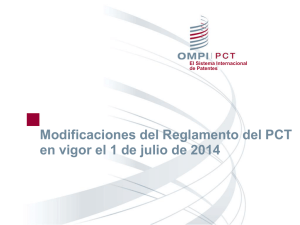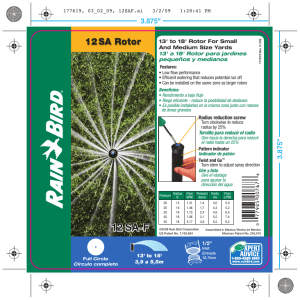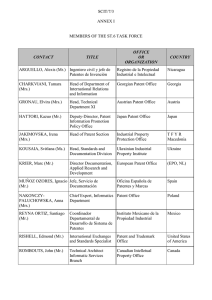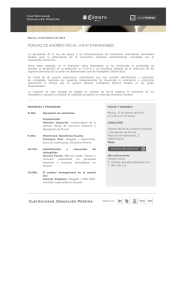Reformatio in peius - Universitat de Barcelona
Anuncio
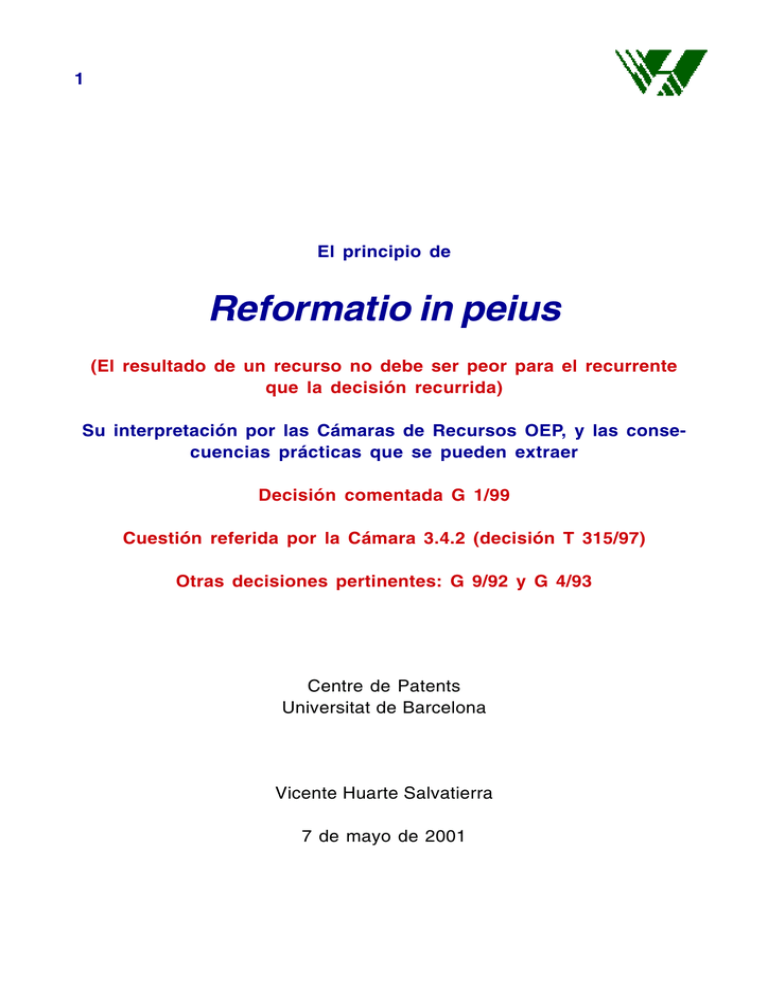
1 El principio de Reformatio in peius (El resultado de un recurso no debe ser peor para el recurrente que la decisión recurrida) Su interpretación por las Cámaras de Recursos OEP, y las consecuencias prácticas que se pueden extraer Decisión comentada G 1/99 Cuestión referida por la Cámara 3.4.2 (decisión T 315/97) Otras decisiones pertinentes: G 9/92 y G 4/93 Centre de Patents Universitat de Barcelona Vicente Huarte Salvatierra 7 de mayo de 2001 2 EP225103-B1 (titular: 3M) OPOSICIÓN (oponente Nippon Carbide) División de Oposición: La patente se mantiene en forma modificada, de acuerdo con una sola propuesta libre y voluntaria de 3M que introduce una nueva característica en la reivindicación principal que restringe el alcance de la patente. RECURSO T 315/97 (Cámara 3.4.2) Recurrente: Nippon Carbide Party as of right (Art. 107): 3M 3M pide que se mantenga la patente tal como se ha modificado en la oposición, pero presenta una petición auxiliar que elimina la restricción introducida durante la oposición. La Cámara concluye que la restricción introducida en la oposición no es aceptable por falta de claridad, pero duda en aceptar la consideración de la petición auxiliar de 3M, ya que en dicho caso el resultado puede perjudicar al único recurrente (el oponente) más allá del alcance de la decisión recurrida (reformatio in peius). Si no acepta considerar la petición auxiliar la patente será revocada completamente. Cuando el afectado por la reformatio in peius es el recurrente-oponente, las decisiones G 9/92 y G 4/93 han sido interpretadas contradictoriamente por las Cámaras de Recursos. La Cámara de recursos decide referir a la Alta Cámara de Recursos la siguiente cuestión: Must an amended claim which would put the opponent and sole appellant in a worse situation than if he had not appealed -e.g. by deleting a limiting feature of the claim - be rejected? G 1/99 3 G 9/92 y G 4/93 For these reasons the two-part point of law referred to the Enlarged Board of Appeal is answered as follows: 1. If the patent proprietor is the sole appellant against an interlocutory decision maintaining a patent in amended form, neither the Board of Appeal nor the non- appealing opponent as a party to the proceedings as of right under Article 107, second sentence, EPC, may challenge the maintenance of the patent as amended in accordance with the interlocutory decision. 2. If the opponent is the sole appellant against an interlocutory decision maintaining a patent in amended form, the patent proprietor is primarily restricted during appeal proceedings to defending the patent in the form in which it was maintained by the Opposition Division in its interlocutory decision. Amendments proposed by the patent proprietor as a party to the proceedings as of right under Article 107, second sentence, EPC, may be rejected as inadmissible by the Board of Appeal if they are neither appropriate nor necessary. 4 G 1/99 (2 de abril 2001) Reasons 2.1 «... Thus, the principle of the prohibition of reformatio in peius is the principle that a decision may not be reached which would put an appellant in a worse position than it was in under the impugned decision. This corresponds to the definition generally recognised in the Contracting States.» 4.1 «It is undisputed that decision G 4/93 decided that the principle of the prohibition of reformatio in peius should be applied in cases where the patent proprietor is the sole appellant against an interlocutory decision maintaining the patent in amended form. This is clearly the wording of paragraph 1 of the order. A patent proprietor can therefore not be placed in a worse position than if it had not appealed. This means that the patent as maintained by the Opposition Division in its interlocutory decision cannot be objected to by the Board of Appeal, either at the request of the respondent/opponent or ex officio. This is balanced by the option open to the opponent to file a request for the revocation of the maintained patent at the national level. 6. «The Enlarged Board of Appeal considers that it results from points 1 to 13 of the reasons for decision G 4/93 that the non-appealing party may not in principle file a request going beyond the extent of the appeal defined in the appellant’s request.» 9.1 «... in the present referred case the patent proprietor was not entitled to file an appeal because the claims maintained by the Opposition Division in its interlocutory decision correspond to the main and only request of the patent proprietor. Thus, the patent proprietor was not adversely affected by the decision and, therefore, was not entitled to file an appeal.... In such a situation, the patent proprietor is aware that, if the Opposition Division allows its main request, it will lose the right to file an appeal because that decision will not adversely affect it.» 5 9.1 «This means that, if the version of the patent held allowable by the Opposition Division is also held allowable by the Board, then, because the patent proprietor intentionally accepted this version either by making it the basis of its main request before the Opposition Division or by not filing an appeal, the proprietor/respondent may not in principle request another version of the patent during the appeal proceedings, unless this version is a restriction of the maintained version.» 12. «... As stated in G 4/93, the proprietor/respondent is primarily limited to defending the version of the patent held allowable by the Opposition Division. However, in particular if the patent cannot be maintained for reasons which were not raised at the first instance, the non-appealing proprietor deserves protection for reasons of equity.» 13.1 «When prohibition of reformatio in peius is applied to cases where the patentee is the sole appellant, if the opponent/respondent considers that the patent as finally maintained is not a valid one, there is a remedy because it has an opportunity to request the revocation of the patent at the national level.» 13.2 «The consequences of the application of the same principle to cases where the patent proprietor is party as of right in the appeal proceedings are completely different. Indeed, if the Board of Appeal comes to the conclusion that it is not possible to maintain a patent there is no remedy for the patent proprietor, neither at the level of the EPO nor at the national level since no appeal or action may be filed against that decision.» 13.3 «... This means that the patent proprietor will definitively lose any protection as a direct consequence of an inadmissible amendment held allowable by the Opposition Division in its interlocutory decision, whereas the deletion of the added feature as such would have avoided the direct revocation of the patent.» 14. «... it would be inequitable for the patent proprietor not to be given a fair opportunity to mitigate the consequences of errors of judgement made by the Opposition Division. Therefore, the patent proprietor may be allowed to file requests in order to overcome this deficiency. 6 Order For these reasons, it is decided that the question of law referred to the Enlarged Board of Appeal by Technical Board of Appeal 3.4.2 in its decision T 315/97 is answered as follows: In principle, an amended claim, which would put the opponent and sole appellant in a worse situation than if it had not appealed, must be rejected. However, an exception to this principle may be made in order to meet an objection put forward by the opponent/appellant or the Board during the appeal proceedings, in circumstances where the patent as maintained in amended form would otherwise have to be revoked as a direct consequence of an inadmissible amendment held allowable by the Opposition Division in its interlocutory decision. In such circumstances, in order to overcome the deficiency, the patent proprietor/respondent may be allowed to file requests, as follows: - in the first place, for an amendment introducing one or more originally disclosed features which limit the scope of the patent as maintained; - if such a limitation is not possible, for an amendment introducing one or more originally disclosed features which extend the scope of the patent as maintained, but within the limits of Article 123(3) EPC; - finally, if such amendments are not possible, for deletion of the inadmissible amendment, but within the limits of Article 123(3) EPC. 7 Consecuencias prácticas a extraer Todas las fases del procedimiento europeo, exámen, oposición y recurso, son muy importantes. Un examen o una oposición enfocadas erróneamente pueden tener como consecuencia una mala situación que no tenga solución en un recurso. Durante una oposición, el titular de la patente debe intentar, con inteligencia, que al menos una de sus propuestas de modificación de reivindicaciones sea rechazada por la DO, ya que si solamente presenta una propuesta, y es aceptada en su integridad, pierde la legitimación para presentar un recurso y capacidad de defensa en el recurso que eventualmente presente el oponente. Durante la oposición, el oponente debe intentar argumentar, por separado y de manera explícita, contra todas las propuestas de modificación de reivindicaciones (principal y auxiliares) que presente el titular de la patente, ya que no podrá presentar recurso contra las decisiones de la DO que no contradigan las posiciones que ha mantenido. La decisión de presentar un recurso no debiera ser tomada de forma automática por el oponente, sino que debiera ser fruto de una reflexión que tenga en cuenta que hay una posibilidad, aunque sea pequeña, de que el tiro le salga por la culata. En cambio, el titular de la patente solamente debe temer los recursos presentados por los oponentes, ya que los que él presente, sea contra una decisión de la División de Examen como contra una de la DO, en ningún caso pueden dar lugar a una decisión que perjudique su situación antes del recurso.
